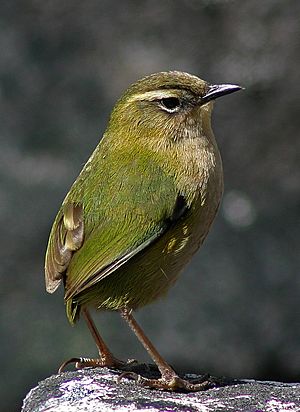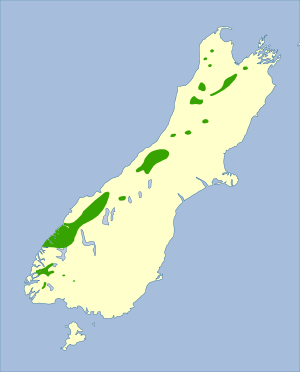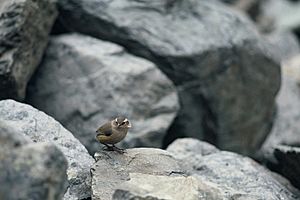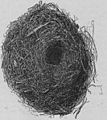New Zealand rock wren facts for kids
Quick facts for kids New Zealand rock wren |
|
|---|---|
 |
|
| Conservation status | |
| Scientific classification | |
| Genus: |
Xenicus
|
| Species: |
gilviventris
|
 |
|
The New Zealand rock wren (Xenicus gilviventris) is a tiny bird that lives only in the South Island of New Zealand. It is part of a special bird family called Acanthisittidae, known as the New Zealand wrens.
In the Māori language, this bird has several names. These include pīwauwau, which means "little complaining bird." It is also called mātuitui and tuke. The name tuke means "twitch," and it refers to the bird's unique bobbing movement. Outside New Zealand, people sometimes call it the rockwren or South Island wren to avoid confusing it with a different bird, the rock wren from North America.
Today, the rock wren lives only in the high alpine and subalpine areas of the South Island. However, old fossil bones show that it once lived in the North Island too. This bird is not a strong flier. It prefers to stay on the ground, hopping and running. It finds its food in low bushes, open rocky areas called scree, and places with loose rocks.
The rock wren and the rifleman are the only two types of New Zealand wrens still alive today. The rock wren's closest relatives were the extinct stout-legged wrens and the extinct bushwren. Sadly, the number of rock wrens is decreasing. This is mainly because of animals like stoats and mice that were brought to New Zealand by humans.
Contents
What Does the Rock Wren Look Like?
The rock wren is a very small bird. It has a short tail, making it look almost tailless. It has long legs, which it uses to hop and run. Its wings are rounded, and it uses them to fly only short distances.
Male rock wrens weigh about 16 grams, while females are a bit heavier at 20 grams. Males are usually greenish with yellow sides and a pale belly. Females tend to be browner. The exact colors can be slightly different depending on where the birds live.
Where Do Rock Wrens Live?
This bird lives only in the high mountains of the South Island. You can find them in the Southern Alps, the Tasman Mountains, and the Victoria Range. They live at very high altitudes, from about 900 to 2500 meters above sea level. The rock wren is the only bird in New Zealand that truly lives in alpine areas all the time.
Before people from Polynesia arrived in New Zealand, fossil evidence suggests that rock wrens also lived in lowland forests and even in the North Island. Their current mountain homes are places where few rodents can survive. These areas are full of rocks for shelter and thick plants.
Rock wrens like to live near the treeline. They prefer places with rockfalls, scree (loose rocks), open grassy areas, and low bushes. Unlike many mountain birds, rock wrens do not move to lower, warmer places in winter. Instead, they seem to find shelter and food in rockfalls under the snow.
Rock Wren Behavior and Life Cycle
The rock wren is not a good flier. It rarely flies more than 2 meters off the ground. It also usually flies for short distances, less than 30 meters. It prefers to hop and run, often with a special bobbing motion and quick wing flicks. Its call is made of three high-pitched notes, and sometimes a pair of wrens will sing together.
Rock wren pairs stay together all year round. They work together to build a large, enclosed nest with a tunnel for an entrance. The nest is lined with soft feathers, often from other types of birds. In the 1930s, a naturalist named Herbert Guthrie-Smith found 791 feathers in one nest! Most were from wekas, but some came from kiwis, kakapos, keas, and kererus. Rock wrens are such good feather collectors that their nests have even been checked to see if rare kakapo feathers are nearby.
Around three eggs are laid in late spring. The parents sit on the eggs for about three weeks. The chicks stay in the nest for about 24 days until they are ready to fly. The parents continue to feed them for at least four more weeks.
Rock wrens mostly eat small insects and other invertebrates found on the ground. But they will also sometimes eat berries and seeds. They even drink nectar from flax flowers.
Protecting the Rock Wren
In the 1930s, Herbert Guthrie-Smith thought the rock wren would be safe from changes in New Zealand. He believed that animals like deer, rabbits, and rats, which caused problems elsewhere, would not bother the rock wren in its high, lonely mountain home. He thought the birds would have enough food and shelter.
However, this was not true. Since Europeans settled in New Zealand, rock wrens have become harder to find in many areas. A study of over 2,100 sightings between 1912 and 2005 showed that the area where they live has shrunk a lot since the 1980s. In the Murchison Mountains, the number of rock wrens dropped by 44% in 20 years.
The biggest threats to rock wrens are stoats and mice. These animals eat the wrens' eggs and young chicks. A study in 2012–13 in the upper Hollyford area showed that stoats were attacking most rock wren nests. Setting traps for these predators helped more eggs hatch and more chicks survive.
Climate change is also a long-term threat to their mountain home. Warmer temperatures could allow rats to move higher into the mountains, where they could harm the wrens.
To help protect the rock wren, 40 birds were moved to Secretary Island between 2008 and 2010. This island in Fiordland is free of rodents. In 2010, a survey found 12 young rock wrens that had not been banded. This was a good sign that the birds were successfully breeding on the island.
Images for kids
See also
 In Spanish: Acantisita roquero para niños
In Spanish: Acantisita roquero para niños





